
Cryptocarya rigida is a small tree or shrub growing in high rainfall areas in north eastern New South Wales, Australia. It was described in 1864 by Carl Meissner in Prodromus Systematis Naturalis Regni Vegetabilis. Extinct in the Illawarra region, allegedly seen in the Illawarra in 1818 by Allan Cunningham.

Cryptocarya glaucescens, commonly known as jackwood, is a rainforest tree of the laurel family growing in eastern Australia.

Cryptocarya obovata is a species of laurel growing on basaltic and fertile alluvial soils in eastern Australian rainforests. It is found from Wyong in New South Wales to Gympie in the state of Queensland. Extinct in the Illawarra region, allegedly seen in the Illawarra in 1818 by Allan Cunningham. The species was included in the Prodromus Florae Novae Hollandiae et Insulae Van Diemen, 402 (1810)
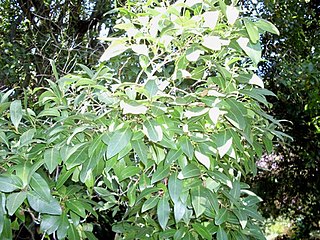
Beilschmiedia elliptica, known as the grey walnut is a rainforest laurel growing in eastern Australia. The range of natural distribution is from Forster, New South Wales to Fraser Island in south eastern Queensland. Beilschmiedia elliptica grows in warm temperate and sub tropical rainforests. Not a rare species, but seldom identified in the rainforest.

Vitex lignum-vitae, known in Australia as yellow hollywood or "lignum-vitae", is a rainforest tree of eastern Australia. The natural range of distribution is in dry, sub-tropical or tropical rainforest from the Richmond River, New South Wales to Cape York Peninsula at the northernmost tip of Australia. It also occurs in New Guinea. Lignum vitae is Latin for "wood of life".

Backhousia leptopetala is a common Australian tree, growing from Stanwell Park in the northern Illawarra district to near Buderim in south eastern Queensland.

Endiandra pubens is a rainforest tree growing in eastern Australia. The habitat is subtropical rainforest growing near streams in valleys. The range of natural distribution is from the Bellinger River, New South Wales to Bulburin National Park, south west of Gladstone, Queensland.

Endiandra discolor is an Australian tree, growing from near Gosford, New South Wales to Tully, Queensland in the tropics. Common names include rose walnut and domatia tree.

Endiandra virens is an Australian tree in the laurel family. Growing from Boorganna Nature Reserve north west of Taree, New South Wales to Kin Kin in Southern Queensland. Common names include White Apple, Plumwood, and New South Wales Walnut.

Cryptocarya bidwillii, the yellow laurel, is a small to medium-sized tree in the laurel family. Occurring in Australian rainforests from Nymboida in the state of New South Wales to Townsville in tropical Queensland. Often found in the dryer ridges in dry rainforest or in viney scrubs.
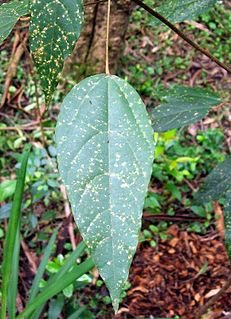
Mallotus discolor is an Australian rainforest tree in the spurge family. It is known as the yellow kamala, due to the yellowish orange fruit covering, which produces a yellow dye.

Mallotus philippensis is a plant in the spurge family. It is known as the kamala tree or red kamala or kumkum tree, due to the fruit covering, which produces a red dye. However, it must be distinguished from kamala meaning "lotus" in many Indian languages, an unrelated plant, flower, and sometimes metonymic spiritual or artistic concept. Mallotus philippensis has many other local names. This kamala often appears in rainforest margins. Or in disturbed areas free from fire, in moderate to high rainfall areas.

Austrobuxus swainii is a rare rainforest tree in the Picrodendraceae family. It is endemic to north east New South Wales and south eastern Queensland, Australia. Occurring from the Bellinger River in the south to Tallebudgera Creek in the north. The common names are pink cherry or hairybark. The habitat is less fertile sedimentary based soils, often associated with the Coachwood, in high rainfall areas. Listed on ROTAP, as a threatened species, with a rating of 3RCa.
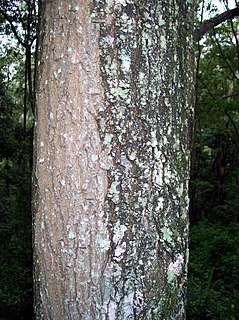
Bridelia exaltata, known as the brush ironbark or scrub ironbark, is a tree of eastern Australia. It occurs in and on the margins of the drier rainforests. Also occurring by streams, often in association with the Black Bean, up to an elevation of 600 metres above sea level. It occurs from Seal Rocks, New South Wales to Maryborough, Queensland.
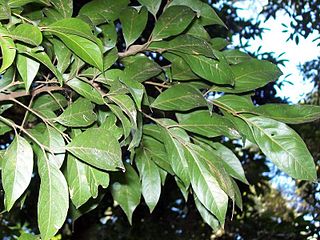
Sarcopteryx stipata, known as the steelwood, is a rainforest tree of eastern Australia occurring from the Bulga Plateau and Comboyne Plateau north west of Taree, New South Wales as far north as Fraser Island off the coast of south eastern Queensland. It grows in sub tropical rainforest but sometimes occurs in warm temperate rainforests on poorer soils. It is a member of the soap berry family. The generic name Sarcopteryx translates to "fleshy wing", as the fruit can be wing shaped. Stipata means "surrounded". The common name steelwood refers to the very tough, hard and heavy timber.

Endiandra introrsa is a rare rainforest tree growing in eastern Australia. Listed with a Rare or Threatened Australian Plants (ROTAP) rating of 3RCa. Its habitat is warm temperate rainforest on the poorer rainforest soils, mostly over 300 metres in altitude, and its range of natural distribution is from near Dorrigo to various sites in the state of Queensland.

Endiandra muelleri subsp. bracteata, is a rare rainforest tree growing in eastern Australia. Listed as endangered by extinction. It is a subspecies of the tree known as green-leaved rose walnut, or Mueller's walnut, Endiandra muelleri. It occurs from Maclean, New South Wales to Mackay, Queensland, usually in sub tropical rainforest at the lower altitudes.
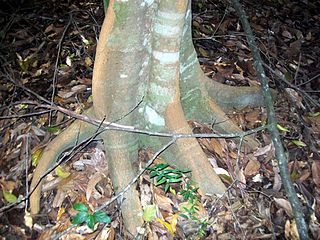
Endiandra muelleri is a rainforest tree of eastern Australia. Its habitat is in warm temperate rainforests on poorer soils. Distributed from the Allyn River in the Barrington Tops region in the south to Kroombit Tops to the north in central Queensland.
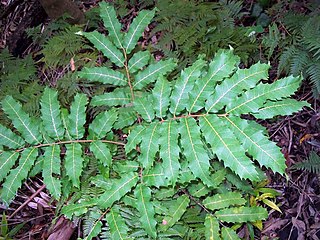
Cupaniopsis newmanii is a rainforest plant in the soapberry family. It is native to eastern Australia. The common name is long-leaved tuckeroo. A rare plant, with a ROTAP listing of 2RC-. The habitat sub tropical rainforest ranging from Mullumbimby in New South Wales to Gympie in south-eastern Queensland.

Bosistoa floydii, commonly known as the five-leaf bosistoa or five-leaved bonewood, is a species of small rainforest tree that is endemic to north-eastern New South Wales. It has pinnate leaves usually with five elliptic leaflets, and panicles of tiny, creamy white flowers.






















